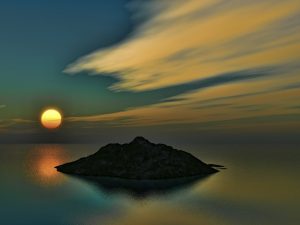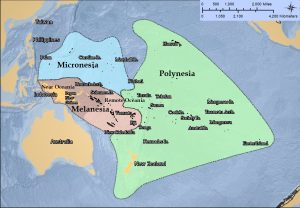11 Pacific Realm
How do we define this region?

Photo by driver Photographer
This course is Geography of the Western World. So, what is the Pacific Realm?
This course is a Regional Geography course. When geographers create regions, they strive to incorporate as many similarities as possible in order to develop a recognizable region, while keeping out differences. So, what are the similarities of the Pacific Realm?
Recall how we defined the Western World. We stated, “If a country’s society speaks an Indo-European language, predominantly and historically professes the Christian faith, and borders another country in the Western World (or if an island, then is nearby), then it is in the Western World.”
So, given that definition, we move to the Pacific Realm. Obviously, the next required criterion is that the country or island must at least border the Pacific Ocean, preferably is surrounded by the Pacific Ocean.
Of course, by itself that simple Pacific criterion eliminates many countries from consideration, but it still leaves in a number of countries that should not be counted in the Pacific Realm.
First, we need to exclude countries that very apparently belong in other regions. The United States and Canada both have Pacific coastal regions, yet represent their own region – North America. Russia’s eastern border splashes with Pacific waters, but Russia is the main piece of the region that we are characterizing as the Russian Domain. Chile and several countries of South America do not belong in the Pacific Realm region. Mexico and most Central American countries have Pacific coastal areas, but along with South America are key parts of the Latin America and the Caribbean region.
Second, we must apply our religious and linguistic criteria. The Philippines has thousands of islands surrounded by the Pacific Ocean, has a dominantly Christian population, but does not have an Indo-European language. Out, the Philippines goes to Southeast Asia. South Korea borders the Pacific Ocean and has a noteworthy Christian population, but like the Philippines, it does not feature an Indo-European language. South Korea is in East Asia. We eliminate a number of countries with these tests.
We do have an unusual situation with the island New Guinea. The whole island is the second largest island in the world, yet it is divided politically into two rough halves. The western side is the Irian Jaya or West Papua province of Indonesia. Like its eastern neighbors, the peoples there are dominantly Christian (about 83%), but as with other examples noted above, this place does not have a main Indo-European language (although it has a few hundred languages!). The eastern half of the island is the main portion of the country Papua New Guinea (PNG). Here 95% of the people are Christian, including a surprising number of Lutherans. Although there are over 800 languages spoken in PNG, English is an official language. Thus, we do count Papua New Guinea in the Pacific Realm.
Although PNG has a large land area, it is manifestly apparent that the areal leader of the Pacific Realm is Australia. With about 25 million people, Australia also is the clear frontrunner in population size. Australia’s eastern coast and part of its northern coast feature the Pacific Ocean, though Australia also borders the Indian Ocean and the Southern (or Antarctic) Ocean. Its historical links with Britain provided Australia with its non-native population’s heritage, language, and religion. Although the early characteristics of Britain’s link with New Zealand vary from those with Australia, again we find the British influence over the non-native population’s heritage, language, and religion. So, we easily add Australia and New Zealand to the Pacific Realm.

Cartography by James McGinty.
As you will read in the essay on Melanesia, geographers created three sub-regional groups of the Pacific Realm – Melanesia, Micronesia, and Polynesia. These three island groups added to Australia and New Zealand comprise the Pacific Realm. We also should note that some of the islands of the Pacific Realm still are colonial pieces of European powers; however, we still include them as in the Pacific Realm, at times with a footnote or asterisk explaining their territorial status. See Hawaii, Easter Island, and French Polynesia for instance.
Having thus made the list of countries and territories of the Pacific Realm, what else is typical of these places?
- Colonial legacy. From biggest – Australia – to the host of very small islands, these islands are or were held by European or American powers – Britain, France, Spain, Netherlands, Germany, and the United States.
- Tourist economies. Tourism is a big industry in Australia and often a key economic component of the island nations of the Pacific Realm. Fiji, Tahiti, and others are well-known for tourism. Tropical beaches appeal to many tourists.
- Tropical agriculture. Given their locations, these islands often have the opportunity to produce agricultural products than cannot be cultivated in the mid-latitude locations of large agricultural regions, such as in the USA. Hawaii’s pineapple crop is an example.
- Occasionally surprising natural resources. Don’t count Australia in this category. The vast area of Australia contains large quantities of a variety of natural resources. However, the modestly-sized New Caledonia has a huge store of nickel ore and other resources, quite out of proportion to its land area. For most of the 20th century, phosphate mining produced large quantities in the small island Nauru (from centuries of bird droppings).
Did You Know?
The Pacific Ocean is the world’s largest and deepest ocean. Portuguese explorer Ferdinand Magellan named the ocean for its calm appearance.
As seen in the map above, some geographers include the whole island of New Guinea in Oceania.
Cited and additional bibliography:
driver Photographer. 2016. South Pacific Island. https://tinyurl.com/southpacificisland. Attribution-ShareAlike 2.0 Generic (CC BY-SA 2.0).
McGinty, James. 2020. “Pacific Realm.” College of DuPage. College of DuPage GIS class. Instructor Joseph Adduci.


